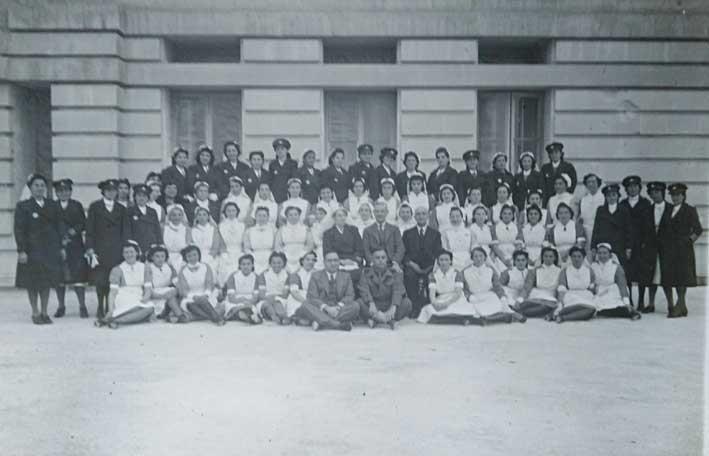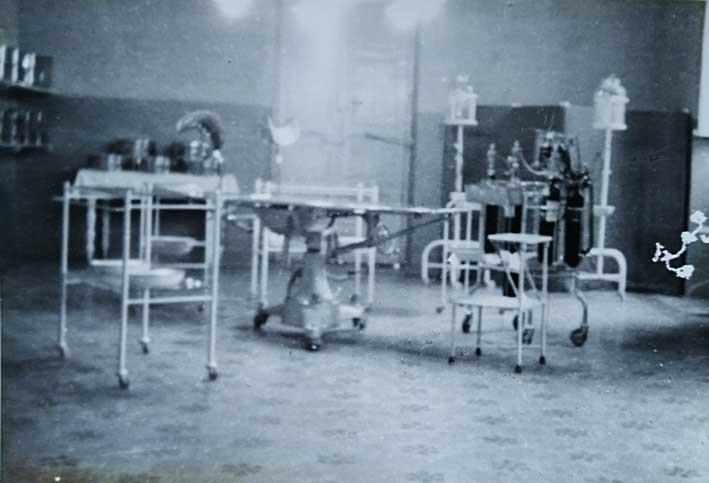Throughout the annals of history, Malta has been visited by many dreaded diseases and wars. Perhaps never in its 7,000-year-old history was Malta besieged in such a ferocious manner as during 1940-43.
Were it not for the well-prepared and all-round organised mobilisation effort, Malta would have succumbed to major superior enemy forces. Credit to this resilience and high morale should be granted to those individuals who were in high responsibility positions. They were, among many others, the ones who, with the help of Almighty God, planned, organised and led Malta's population out of the dark tunnel with flying colours.

St. John Ambulance Brigade at St Luke's Hospital 1944, including Prof. Bernard
One particular organisation in the war civil defence effort was the Medical and Health Department, which during wartime Malta was under Professor Albert V. Bernard (of French ancestry). Born in Valletta, Professor Bernard's role during Second World War Malta was pivotal in the organisation of the health department.

Maltese surgeons and Royal Army Medical Corps (RAMC) officers who served during wartime Malta including Prof. Bernard
During the Italo-Abyssinian War of 1935, Bernard had already proven his acumen in the treatment of casualties of chemical warfare and the organisation of plans for medical cases if war arose on a large scale. His lectures on the medical implications of chemical warfare and emergency medical services for civilian casualties were most enlightening and put to use later on as the Second World War broke out. Bernard was also prolific in publishing papers on medical, health and historical papers. Before the Second World War, Professor Bernard had already been nominated a Member of the British Empire in 1919 for his services to the military medical authorities during the First World War.
During the Second World War, the Medical and Health Department was under the responsibility of the Chief Government Medical Officer (CGMO), the District Medical Officers and the Area Protection Officers. The Medical and Health Department also worked in close liason with the Royal Army Medical Corps (RAMC). Both were engaged in implementing preventive and curative measures which were among the most common lines of action. This included mainly the following:
- Health Awareness and Education
- Inoculations (for example for tubercolosis and typhoid)
- Infirmaries (Bereġ in Maltese) and First Aid Centres
On 30 October 1937, Ordinance XXX appeared in the Government Gazette in order to provide for the reorganisation of departments and for the setting up of the Medical and Health Department. All those hospitals and other medical establishments that up to that date were under the control of a charitable institution were put under the direct control of the CGMO. Prof. Bernard was instrumental in the reorganisation and setting up of the following main institutions of the Medical and Health Department between 1941 and 1943 to serve the war effort:
- Two civil defence units: one based in Valletta and another in Cottonera
- Blue Sisters Hospital, St Julian's
- Bugeja Hospital, Ħamrun
- Central Hospital, Floriana
- Mental Diseases Hospital
- Qormi Government School
- St Aloysius Hospital, Birkirkara
- St Vincent de Paul Hospital, Luqa
- Stores ARP, Sta Venera
- St Theresa Orphanage, Żurrieq
- St Luke's emergency Hospital, Guardamangia

First operating theatre at St Luke's Hospital (circa 1930s)
J. Cauchi, (CGMO), writing in 1947 puts these words in action to describe the success of the Medical and Health Department under the CGMO, Pofessor Bernard: "For many years Prof. Bernard has taken a leading part in the activities of the St John's Ambulance Brigade, which provided an invaluable auxiliary nursing service for the emergency hospitals of which Prof. Bernard was in charge during 1940-45."
Professor Bernard was also a popular voice during broadcasts on the Rediffusion. With the threat of invasion imminent, the people were advised during these broadcasts of the precuations to be taken. A frequent broadcaster, Prof. Bernard, CGMO, gave details of the scheme to ensure medical and health services would continue to function under attack.
Among many other matters, Prof. Bernard was helpul in appointing a resident district medical officer, a local sanitary inspector and in sending necessary equipment for accidents to help the poor in Dingli village.
On 28 January 1942, an investitute was held at the Palace Valletta where Prof. Bernard was made Commander of the Order of the British Empire.
Prof. Bernard retired in 1945 on reaching pensionable age. He passed away in 1955 holding various distinctions by the British Imperial Government: MBE (1919), OBE (1928), CBE (1942) and CMG (1945). For his services during the earthquake in Calabria (Italy), Bernard was made an officer of the Crown in Italy.
Interestingly, St Luke's Hospital was so named by Prof. Bernard, who was CGMO, who felt that this island should commemorate the beloved physician, the Apostle Luke who visited it in 60AD in the company of the Apostle Paul.
The first stone of St Luke's was laid with great pomp by His Excellency Sir John du Cane, "the leading citizen" of his day, on 5 April 1930. The story of St Luke's Hospital has close link with Prof. Bernard in that before the laying of the first stone, government did not have sufficient funds to buy the land on which the hospital was to be built. Through an act of sheer philanthropy, Prof. Bernard bought the land himself and when government had enough funds to buy it, he sold it at the same rate as he purchased it so that the hospital could be built.
In writing this article I am greatly indebted to family Bernard who provided information and photos on Prof. A. V. Bernard.